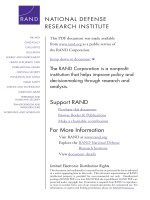The Ethics of Environmentally Responsible Health Care docx
Bạn đang xem bản rút gọn của tài liệu. Xem và tải ngay bản đầy đủ của tài liệu tại đây (8.99 MB, 166 trang )
The
Ethics
of
Environmentally Responsible
Health Care
This page intentionally left blank
The
Ethics
of
Environmentally
Responsible
Health
Care
Jessica
Pierce
Andrew
Jameton
OXPORD
UNIVERSITY
PRESS
2004
OXFORD
UNIVERSITY
PRESS
Oxford
New
York
Auckland
Bangkok Buenos Aires
Cape
Town Chennai
Dar es
Salaam Delhi Hong Kong Istanbul Karachi Kolkata
Kuala
Lumpur Madrid Melbourne Mexico City Mumbai Nairobi
Sao
Paulo Shanghai Taipei Tokyo
Toronto
Copyright
©
2004
by
Oxford University Press, Inc.
Published
by
Oxford University
Press,
Inc.
198
Madison
Avenue,
New
York,
New
York, 10016
Oxford
is a
registered
trademark
of
Oxford University
Press
All
rights reserved.
No
part
of
this publication
may be
reproduced,
stored
in a
retrieval
system,
or
transmitted,
in any
form
or by any
means,
electronic, mechanical, photocopying, recording,
or
otherwise,
without
the
prior permission
of
Oxford University
Press.
Library
of
Congress
Cataloging-in-Publication
Data
Pierce,
Jessica,
1965-
The
ethics
of
environmentally responsible health
care/
Jessica
Pierce,
Andrew Jameton
p. cm.
Includes bibliographical references
and
index.
ISBN
0-19-513903-8
(cloth)
1.
Medical ethics.
2.
Environmental
health—Moral
and
ethical aspects.
3.
Bioethics.
4.
Environmentally induced
diseases—Moral
and
ethical aspects.
I.
Jameton,
Andrew.
II.
Title.
R725.5.P547
2004
174'.2—dc21
2003042901
987654321
Printed
in the
United States
of
America
on
recycled, acid-free paper
using
soy-based
ink
Preface
Our
feeling
for
nature
is
like
the
feeling
of
an
invalid
for
health.
—Friedrich
Schiller,
On
Naive
and
Sentimental
Poetry,
1795-96
Bioethics originally encompassed both ecological
and
clinical concerns (Potter
1971),
but
almost immediately separated
into
distinct disciplines: bioethics, con-
cerned
with
clinical practice,
and
environmental ethics. Though
the fields
still share
a
common philosophical foundation, they
are
profoundly disconnected
in
their
practical concerns (Whitehouse 1999).
Health-care ethics zooms
in on
individual patients
and
their caregivers; envi-
ronmental
ethics deals
in
large populations,
human
and
nonhuman. Clinical ethics
episodes
are
usually
resolved
in
days, weeks,
or
months; ecologists
and
environ-
mental
philosophers
reflect
on
decisions
and
policies
that play
out
over
decades,
centuries,
and
even millennia. Typically working
in
large medical centers amply
supplied
with skilled personnel, ingenious devices,
and
complex therapies, health-
care
ethicists
tend
to be
optimistic about
the
value
of new and
complex technolo-
gies
and the
ability
of
ethical principles
to
manage potential
difficulties.
Environmen-
talists,
who
serve among
the
witnesses
to
widespread human poverty, increasing
toxicity,
and
disappearing biodiversity, tend
to be
skeptical about
the
potential
of
new
technology
to
solve human problems.
The
values
and
concerns
of the two
fields
differ:
health-care ethicists
focus
on
autonomy, advocacy, clinical benefits,
avoiding harm
to
patients,
and
fairness
in
limiting
costs.
Environmental
philoso-
phers consider such values
as
sustainability, ecosystem integrity, global intercon-
nection, limits
to
growth,
and
respect
for
nature.
v
VI
PREFACE
Can
these
two
fields,
so
similar
in
their philosophical foundations
and so
dif-
ferent
in
their vocabulary
and
issues,
be
grasped
in a
unified
way? There
are
good
reasons
to
view
the two
fields
as
interconnected:
High quality,
ethically
sound
health care
can
survive only
if the
larger environment survives
and
sustains health.
As
individuals with integrity,
we
cannot
safely
separate
our
concern
for the
world
from
our
daily
lives.
If we are to
make sound
ethical
judgments
in
health
care,
we
need
to
consider
the
environmental implications
of our
decisions.
How
then should clinicians
and
health-care ethicists take into account
the
grim
global context outside health care that environmental ethicists
are so
concerned
about? What concepts
from
environmental ethics
can be
applied
to
health care,
and
how can
they
he
combined with more traditional health-care ethics concepts?
What kinds
of
case studies
in
health care highlight both clinical
and
environmen-
tal
principles? What sorts
of
activities
and
responsibilities among clinicians
and
hospital
administrators
express
an
environmental awareness? What
sorts
of
prob-
lems
and
obstacles, both theoretical
and
practical, stand
in the way of
environ-
mentally
sound health care practice?
Environmental principles
are
central
to a
responsibly inclusive understanding
of
bioethics
and
conduct
of
health care.
Our
argument
for
this
is
threefold:
First, environmentalism carries
a
clear
and
distressing message about
the
state
of
the
earth's
ecosystem
and the
prospects
for
life
during
the
next
few
centuries.
If
the
warnings
of
environmental scientists continue
to go
unheeded,
the
fate
of
humanity
is
bound
to be
dismal.
Already,
a
substantial portion
of
earth's
popula-
tion
is
living
in
great poverty,
and if
more
suffering
from
environmental decline
is
to be
avoided,
significant
measures need
to be
taken
to
limit both population
and
consumption, primarily
by the
wealthiest sector
of the
world's population.
Unless
the
human burden
on the
biosphere
is
relieved, expensive health-care tech-
nologies
cannot
eliminate
disease
and
suffering.
Second, health care itself imposes
significant
environmental costs that
can be
reduced without harm
to
public health. Although
the
toxicity
of
health-care prac-
tices
is the
most
commonly
addressed
of
these
costs
in the
United
States,
health
care
has a
problem
of
overscale
as
well. Clinicians
and
ethicists need
to
take
a
wider view
of
clinical technologies that includes their environmental costs through-
out
their
full
life
cycle
of
production, use,
and
disposal. Some health occupations
already accept
a
responsibility
for the
stewardship
of
resources,
but
every health
profession needs
to
accept
responsibility
for
reducing
the
environmental impact
of
its
services.
Third, design concepts
and
principles that
are
readily
found
in
environmental
and
ecological
thinking
can be
applied
fruitfully
to
health-care
practice.
Yet
ethi-
cal
dilemmas arise
in
balancing advocacy
for
patients with stewardship
of
envi-
ronmental resources. Reflection
on
these dilemmas
in
turn
fosters
a
reinterpretation
of
common principles used
in
health-care
ethics—such
as
autonomy, beneficence,
avoiding harm,
and
justice—in
the
light
of
environmental concerns.
PREFACE
Vll
A
common criticism
of
drafts
of
this book
has
been that
it is
"too
idealistic,"
by
which
we
fear
readers mean "unrealistic." Indeed,
if our
reader's sense
of
health-
fulness
and
personal
abundance
depends
on a
belief
that
the
world
still
offers
unlimited
potential
for
material growth, then
our
work
is
unlikely
to
foster con-
viction.
But
everyone,
and
especially
the
world's
wealthiest—that
is, the 20% of
the
world
who use 90% of the
world's
health-care resources (World Bank
1993)—
needs
to
realize that
the
earth's limits
are
real. Personal abundance
can
depend
neither ethically
nor in
fact
on
increased
use of
materials
and
energy. Instead,
our
ideal
of
rescuing people
from
disease
and
suffering
must work within
an
appre-
ciation
of the
earth's
limits.
Longmont,
Colorado
J. P.
Omaha, Nebraska
A. J.
This page intentionally left blank
Acknowledgments
Since
this book
has
been
in
process
off and on for a
decade,
the
list
of
people
to
whom
we are
indebted
is
long.
We
apologize
to
those
who
have helped
us
along
the
way
whom
we
have neglected
to
mention here.
Much
of our
research
was
conducted with
the
generous support
of The
Green
wall
Foundation,
which
has
funded
two
cycles
of
research: "The Green Health Center
Project"
and
"Exploring Bioethics Upstream." Thanks,
in
particular,
to
William
Stubing
for
trusting
in the
value
of our
work during
its
infant
stages
and
tolerat-
ing
its
slow
fruition.
We are
particularly indebted
to the two
"green groups,"
who
met
at
University
of
Nebraska Medical Center with
the
support
of The
Greenwall
Foundation.
The
first
group outlined
and
discussed
the
"manifesto"
and
principles
of
the
Green Health Center described
in
chapter five: Jennifer
Chesworth,
Alan
Diener, Michael Gillespie, Hollis Glaser,
Renee
Irvin,
Michael McCally, John
McClain,
Michael
Pritchard,
Christine Reed,
Hollie
Shaner,
Dale Stover, Mary
Ellen
Uphoff,
Susanna
von
Essen, Julia Walsh,
and
Lynne
D.
Willett.
Thank
you
also
to
those
who
worked
on the
"Exploring Bioethics Upstream"
project that explored UNMC/NHS decision processes regarding environmental
issues:
Jean Amoura, Bruce Dvorak, Karen Falconer
Al-Hindi,
Michael Gillespie,
Donald
S.
Leuenberger, Pamela
McCright,
Catherine McGuire Roussel,
Kristine
McVea, Keith Mueller, Terry Paulsen,
Ron
Schaefer, Barbara Stock, Dale Stover,
Mary
Ellen
Uphoff,
Susanna
von
Essen,
and
Susan Waggoner.
ix
X
ACKNOWLEDGMENTS
We owe
gratitude
to
many
staff
and
administrators
at the
University
of
Nebraska
Medical Center
and
Nebraska Health System
(UNMC/NHS).
We
would like
to
thank,
in
particular, Rick
Boldt,
in
Facilities Management,
for
access
to
committees,
and
for a
wealth
of
information about incinerators, recycling facilities, trashcans,
and
dedication
to the
job.
We
also especially appreciate
the
access
to
facilities,
participation
in
committees,
and
information
so
generously provided
by Joe
Graham,
Jackie
Parmenter,
Frank
Pietrantoni, Michael Powell, Ronald Schaefer,
Carla
Snyder,
Tom
Strudl,
and
others. Thanks
to
James Anderson, chair
of the
depart-
ment
of
Preventive
and
Societal Medicine
at
UNMC,
for
patient
financial
and
professional support
to
both
of us.
Shireen
Rajaram
(University
of
Nebraska
at
Omaha)
and
Catherine McGuire Roussel (Joslyn Institute
for
Sustainable Design)
co-authored some
of the key
papers
of our
project. Christina Kerby Kessinger
has
lent years
of
help
as a
research
assistant
and
grant administrator
and has
provided
valuable
feedback
on
material
in the
book. Christina
is
responsible
for the
lion's
share
of
work
on a
number
of the
case studies presented
in the
text. Angella Bow-
man
composed
and
maintained
the
original project
web
page
(http://www.
unmc.edu/green).
Sue
Nardie helped with details
of the
text. Carmen
Pirruccello
has
provided steady secretarial support.
We
would
like
to
acknowledge
the
contribution
of our
students over
the
years,
especially summer students,
who
contributed ideas, research,
and
writing: David
Mair,
Andrew Page, Bruce
R.
Smith,
and
Colleen Svoboda.
We
also especially
appreciate
the
participation
and
research
help
of
students Chanel Helgason, Jane
Handina
Murigwa Kanchense, Jason Papenfuss, Janis Petzel, Anahita
Rashidi,
Patricia Sullivan,
and
Sarah Webber. Thank
you to
Steve Pergam
and
Gina Ramirez-
Wilson
for
founding
the
Student
Alliance
for
Global Health
at
UNMC.
Carolyn Raffensperger
at
Science
and
Environmental Health Network
and
Michael Lerner
at
Commonweal have provided significant leadership, resources,
and
community
for
conversation
and
ideas.
Their
combined efforts
on the
Blue
Mountain
Lake
and the
Ecological Medicine meetings were particularly impor-
tant.
In
Chapter
five,
we
borrow some
of the
language
and
principles
of the
Feb-
ruary
2002
ecological
medicine
statement posted
at
and
authored
by
Nancy Myers, Kenny Ausubel, Davis
Baltz,
Janine
M.
Benyus, Char-
lotte Brody, Gary Cohen, Tracey Easthope, Kathy Gerwig,
Tom
Goldtooth, Louis
J.
Guillette, Jr., Andrew Jameton, John
M.
Last, Michael McCally, Laurie Monti,
Gary
Nabhan, Jonathan
A.
Patz, Carolyn Raffensperger, Eric Rasmussen,
Satinath
Sarangi,
Ted
Schettler, Julia Walsh, Mark Jerome Walters, Peter Warshall,
and
Michael
Lerner.
We
also received help
from
the
Center
for
Rural
Affairs
(Wyatt Fraas, Martin
and
Linda Kleinschmit), City Sprouts (Katherine Brown
and
Nancy Williams),
Health
Care
Without Harm (Charlotte Brody, Gary Cohen,
and
Jamie Harvie),
the
Healthy Building Network (Tom Lent), Joslyn Institute
for
Sustainable
Design (Catherine McGuire Roussel
and
Cecil Steward), National Association
ACKNOWLEDGMENTS
XI
of
Physicians
for the
Environment (John
Grupenhoff),
The
Nightingale Insti-
tute
for
Health
and the
Environment
(Hollie
Shaner
and
Glenn McRae),
Part-
ners
in
Health (Paul Farmer
and Jim
Kim), Physicians
for
Social
Responsibility
(Michael McCally
and
Robert
Musil),
and the
environmental
affinity
groups
of
the
International Association
of
Bioethics
and the
American Society
for
Bio-
ethics
and the
Humanities.
Many
colleagues
and
friends
provided valuable feedback, inspiration,
and
ideas
which
helped
to
shape
the
text: Peter Adair, William Aiken, Virginia Aita, Rebecca
Anderson,
Tom
Athanasiou,
Paul
Basch,
Arthur
and
Nancy
Bartlett,
Margaret
P.
Battin,
Solomon Benatar, Grazia Borrini-Feyerabend, Stephen Boyden, Donald
A.
Brown, John
H.
Bryant,
Dan
Callahan, Courtney Campbell, Paul
Carrick,
Jody
Carrigan, Christine
Cassel,
Eric
Chivian,
Gary
Comstock,
Carl Cranor, Terry
Davies,
Ron
Davis, Strachan Donnelley, Martin Donohoe, Alan Durning, Howard
Frumkin,
Jennifer Girod, Lynn Goldman,
Sam
Gorovitz, Carl Greiner, Sydney
Halpern, Trevor Hancock, Barbara Heinzen, Warren Hern, Karen
Falconer
Al-
Hindi, Bart Gruzalski, Steve Heilig, Robert
K.
Hitchcock, Rachelle Hollander,
David Hoosen, Lisa Husmann,
Wes
Jackson, Robert
R.
Jacobs, Dale Jamieson,
Derrick Jensen, Albert
R.
Jonsen, Eric Juengst, Allen Katz, Thomas Kelly, Chris
Kiefer,
Fred
Kirschenmann,
Kuang
Yunfei,
Thomasine Kushner,
Steve
Larrick,
Margaret MacKenzie, Ruth Macklin, Anthony
J.
McMichael,
Donella Meadows,
Diane
Meier, Frances Mendenhall, Carolyn Merchant, Carl Mitcham, Anuradha
Mittal, Peter Montague, Andrew Moss, Richard Norgaard, Deborah Novak, Mary
O'Brien,
Tobie
Olsan,
Karen Olson, Stephen
Packard,
Jonathan Patz, Joan Penrod,
Henry Perkins, Cheri Pies, Lisa Potter,
Van
Rensselaer Potter, Connie Price,
Malcolm Potts,
Ruth
Purtilo.
Ravi Rajan, Warren Reich, Leonard
Rifas,
Allan
Rodger, John Ryan, Peter Sauer, Toby
Schonfeld,
Ted
Schrecker, Richard
R.
Sharp, James
and
Sara
Shull,
Barry Smith, Margaret Topf,
Ted
Tsoukalas,
Wil-
liam Vitek, Karen Warren,
Laura
Westra, Mary Terrell White, Peter
Whitehouse,
Jane
Wigle,
Dan
Wikler, Richard Wilkinson, Mary Wilson, Gerald Winslow,
and
Rosalee
Yeaworth.
Jeff
House
at
Oxford
has
been
wonderfully
supportive, patient,
and
insightful.
Thank you.
We
would like
to
give special thanks
to
Roger Pierce
for his
generous support
and
constructive criticism throughout
the
process.
Roger read
and
greatly helped
clarify
the
text
of the
book
through each
of its
five
major drafts,
and has
read,
all
told,
at
least
a
hundred chapters over
the
years. Special thanks
to
Katherine Brown
for
her
clear spiritual vision, patience, inspiration,
and her
keen sense
of
living
with
our
contradictions
on
this small planet.
And,
of
course,
we
would like
to
acknowledge,
and
dedicate this book
to our
families.
Jessica wishes
to
thank Chris
for his
loving patience, Sage
for
introduc-
ing a new
perspective
on the
value
of the
future,
and
Roger
and
Alexandra
for
modeling courage
and
hard work. Andrew wishes
to
express particular gratitude
Xll
ACKNOWLEDGMENTS
to his
grandparents,
all
gardeners
who
loved
the
quiet natural world
of the
Mid-
west,
his
parents—his
mother
a
gardener,
his
father
a
loving
critic—and
his
daugh-
ter
Rachel Jameton,
a
green chemist.
We are
also
grateful
to Ben Lee at
Oxford University Press
for
championing
the use of
recycled paper
and
soy-based inks
in
printing this book.
We are
making
a
donation
on
behalf
of
this book
to the
Arbor
Day
Foundation,
and to the
cities
of
Omaha
and
Longmont
for
planting trees.
Contents
1.
The
Challenge
of
Environmental Responsibility,
1
2.
Linking Health
and
Environmental Change,
8
3.
Population
and
Consumption,
26
4.
Environmental Aspects
of
Health Care,
43
5.
The
Green Health Center,
61
6.
At the
Bedside,
82
7.
Global Bioethics
and
Justice,
95
8.
New
Ways
of
Thinking About Bioethics,
111
Bibliography,
127
Index,
147
xiii
This page intentionally left blank
The
Ethics
of
Environmentally Responsible
Health Care
This page intentionally left blank
j
The
Challenge
of
Environmental Responsibility
Signs
of
Trouble
The
foundation
of
human health rests
on
healthy, stable ecosystems.
Our
biotic
environment provides
us
with
the
fundamentals necessary
for
healthy
lives—food,
water, oxygen, warmth, light,
and
fuel. Earth's ecosystems also supply
the raw
materials
for our
health-care services.
The
global fraying
of
ecosystems
has
grave
implications
for our
health
and our
ability
to
treat illnesses,
now and in the
future.
Although
health around
the
world improved
on
average over
the
last half
cen-
tury,
it is
likely that these gains will
be
lost
if the
environmental foundation
for
health continues
to
deteriorate.
Evidence
accumulates
daily that human health
is
suffering
as
ecosystems sicken.
Billions
of
people
already experience
the
effects
of
degraded
environments. Lack
of
clean water
for
drinking, sanitation,
and
hygiene affects
a
third
to
half
of the
world's
population
and is
responsible
for
seven percent
of all
death
and
disease
globally.
Two and a
half million children
die
each year from diarrhea alone,
the
primary cause
of
which
is
water-borne microorganisms. Hundreds
of
millions
suffer
from hunger
and
malnutrition. Chemical agents, particularly
in air
pollu-
tion,
are
considered major factors
in
increased rates
of
bronchitis,
heart
disease,
and
cancers.
The
incidence
of
asthma
is
mushrooming.
Certain
forms
of
cancer
are on the
rise.
The
health
of
people
all
over
the
globe
is
diminished
by
exposure
1
2 THE
ETHICS
OF
ENVIRONMENTALLY RESPONSIBLE HEALTH CARE
to
toxic substances such
as
lead, mercury, arsenic, cadmium,
and
dioxin.
As
local
and
global
ecosystems show increasing signs
of
stress, human health
is
likely
to
become
far
less stable
and far
more
difficult
to
maintain.
As we
show
in
Chapter
2,
these challenges
to
health
are
clearly global
in
nature,
and
require
a
coordinated response. Climate
is
changing everywhere;
so is the
global distribution
of
nitrogen
and
other basic chemicals
of
life.
Heedless
of na-
tional boundaries, polluted
air and
water travel everywhere.
We
share oceans,
atmosphere,
and
biodiversity.
The
central explanation
for our
environmental predicament
is, as we
argue
in
Chapter
3,
that humans
are
reaching
the
outer limits
of
population
and
material
growth.
The
story
of
Easter Island
serves
as a
metaphor
and
historical
precedent
for
our
current situation:
as the
people
who had
migrated
to
Easter Island around
the
fifth
century prospered
and
their population grew, they
stripped
their tiny land
of
its
natural resources
and
fell
into
a
constant state
of war
over what
was
left.
By
the
sixteenth century they
had all but
destroyed themselves (Ponting 1991, 1-7).
The
earth
as a
whole
is now a
small overcrowded island; there
is
ample reason
to
worry
that
we,
too—all
of
humanity—are
shaping,
and can
already discern,
the
trajectory
of our own
demise.
The
dynamic combination
of
population size, resource consumption,
and
tech-
nology
is
putting tremendous strain
on
natural systems.
The
proportion
of
envi-
ronmental change attributable
to
human impact compared
to
nature
has
increased
vastly
in
recent centuries
and at
exponentially increasing
rates.
Clearance
of
for-
ests,
use of
water, acquisition
of the
products
of
plant growth, occupation
of
land,
pollution
of
water
and
air,
and
mining
of the
earth have
all
grown immensely
and
are
substantially transforming
the
earth. Humans
are now
causing
the
greatest rate
of
species extinction since
the
disappearance
of the
dinosaurs.
In
1700,
the
larg-
est
city
in the
world
was
Istanbul
at
700,000
people;
by
2050,
a
population roughly
equal
to the
world's
present
6.5
billion population
is
expected
to
live
in
cities alone.
Industrial capacity
has
grown about
75
times since 1800. Since 1900, carbon
di-
oxide emissions have grown
17
times
and
water
use 9
times. These figures
offer
a
proportionate
sense
of how
dramatically
the
human relationship
to the
earth
has
changed
in a
very
short
time,
and how
unprecedented
our
situation
is
historically.
The
combination
of the
human economy
and our
population
has
clearly outgrown
the
capacity
of the
earth
to
heal itself (Wilson 1993; Vitousek 1994; Meyer 1996,
2,23;
McNeill
2001,360;
Wackernagel
2002; Brown, Gardner,
and
Halweil 1998,
43).
It is
well beyond reasonable debate that humans must come
to
terms with
natural
limits
by
curbing
the
growth
of
human population
and
altering basic modes
of
material production
to
reconcile human welfare with
a
thriving nature.
Health care
is
itself increasingly environmentally problematic.
As we
explain
in
Chapter
4, the
materials
and
methods
of
health
care
contribute
to
pollution,
add
to
global warming
and
ozone depletion,
and
rely
on an
extensive natural resource
base—the
extraction, manufacturing,
and use of
which incurs
a
significant
envi-
CHALLENGE
OF
ENVIRONMENTAL RESPONSIBILITY
3
ronmental
burden both locally
and
globally. This
is
partly
a
problem
of
scale.
The
United
States maintains
the
world's largest health-care system, spending
close
to
half
of all the
money spent
in the
world
on
health care. Maintaining such
a
large
health-care system requires
a
large economy. That economy, however,
is
making
a
substantial contribution
to the
decline
in the
state
of the
world's environment.
And
environmental decline
is in
turn harming human health
and
creating more
illnesses
in
need
of
treatment.
As the
need
for
health care increases, this already
oversized health-care system, caught
in
this vicious positive feedback cycle,
is
likely
to
respond
by
growing
and
thereby continuing
to
further
compound health
problems.
As
such, health
care
frustrates
its own
practical
and
moral commitment
to
promote
and
maintain human
health.
A
more modest material
and
energy economy
is
critical
to
averting
further
eco-
logical catastrophe.
The
necessary changes
in
modes
of
production
in
society
at
large
will
inevitably entail parallel changes
in
health-care technology
and
delivery.
We
need
not
view these changes
as
losses.
It is
important
to
appreciate
the
positive potential
of
more environmentally sound health care
in
relation
to the
environmental
crisis. Health-care systems will increasingly
be
called
on to
respond
to
environmentally related illness. Clearly, health professionals will need
to
learn
more about
the
environmental basis
of
disease
so
that they
can
effectively
diag-
nose
and
treat their patients. With
a
proper global commitment
to
reproductive
health services, health
care
can
play
a key
role
in
limiting population growth.
It
can
play
a
crucial
role
in
counseling
and
education
about
diet,
environmentally
caused disease,
and
healthy lifestyles.
And
health care
can
continue
to
offer—
and
can
even
strengthen—its
significant
psychological
function
of
providing
as-
surance, care,
and
hope
to
those
who are ill or
injured.
Sustainable
Health
and
Health
Care
To
make such significant changes
in our
outlook
on
health care,
we
need
to re-
think
the
nature
of
health itself.
In
Chapter
5, we
begin
to
describe
a
more eco-
logical concept
of
health that reconciles
and
balances environmental, population,
and
individual health,
and
that orients human well-being toward greater respect
for
its
dependency
on the
health
of
ecosystems.
A
sustainable health perspective recognizes that
the
overall public health gains
realizable
from
health care
are
limited. Allocating resources
to
meet
the
health-
care needs
of
individuals should
be
framed
in the
context
of
maintaining sustain-
able public health
for all
people
and
ecosystems. Thus,
a
potentially unbounded
investment
in the
rescue
of the
acutely
ill and the
treatment
of the
dying must
be
set
aside
to
protect
the
resources necessary
for
prioritizing public health
and
pre-
vention over health-care services. Fewer, more
carefully
chosen treatments
and
technologies
may be
offered,
with
an eye
toward serving
the key
health needs
of
as
many
as
possible, within global environmental constraints.
4 THE
ETHICS
OF
ENVIRONMENTALLY RESPONSIBLE HEALTH CARE
The
move toward sustainable health care
has the
potential
to
resolve many prob-
lems
of our
current health-care system. Health care costs, disorganization, inac-
cessibility, side
effects,
mistakes,
and
disappointments
are
already
at a
high level;
scaling
health
care
down
to a
sustainable
level
can do
much
to
heal
many
of
these
chronic health policy problems. Moreover,
a
sustainable health-care system per-
mits
a
strong commitment
to
social justice
in the
United States.
By
reducing
the
material
scale
of
health care,
a
sustainable system will, instead
of
lowering public
health standards, support
a
higher level
of
access
to
health care
and
public health
services
for
more people.
Sustainable health care recognizes that health
is a
global concern, which
im-
plies
a
strong principle
of
equality.
We
should seek
to
promote
the
environmental
requirements
of
health
(a
healthy ecosystem, clean water,
food,
hygiene,
and
shel-
ter), basic public health services (immunizations, reproductive health services,
prenatal care),
and
modest health care
for
all, around
the
globe.
In
addition
to
scaling down, sustainable health
care
can
embody environmen-
tal
values through design
of
buildings
and
grounds, choice
of
products, even
the
food
served
in the
cafeteria.
An
increased appreciation
of
limits
and of
intercon-
nection will
affect
what people value
in
health care.
Yet
there
are
many practical
and
ethical issues involved
in
working toward
a
sustainable
health-care system,
one
that
is
responsive
to
environmental limits
and
willing
to
reset priorities
in
order
to
balance good human health with ecological
health
(as
there
are
many moral implications
of
choosing
to
ignore environmen-
tal
limits).
To
explore
the
ethical
principles
of
sustainable health
in
practice,
we
present
in
Chapter
5 the
idea
of the
Green Health Center (GHC),
a
hypothetical
health-care institution that embodies
the
values
of
sustainable health.
The GHC
would
integrate
environmental
considerations
into
the
design
of its
buildings,
grounds, transportation systems, energy,
and
waste
flows.
The
types
of
products
and
technologies used
in the GHC
would
be
evaluated with environmental costs
in
mind.
The
institution would
offer
a
limited range
of
services
and
seek
to
pro-
vide adequate,
efficient,
and
widely accessible care that
is
both economically
and
environmentally sustainable.
The
mission
of the GHC is to
demonstrate that sus-
tainable health care
is a
feasible goal, both practically
and
morally,
and to
high-
light areas
of
particular ethical concern.
In
Chapters
5 and 6, we
examine some
of the
specific moral tensions generated
by
taking environmental concerns seriously.
We ask
such questions
as: Is
envi-
ronmental cost
a
legitimate
factor
to
consider
in
weighing
the
clinical value
of a
particular treatment
or
technology?
Should only
those
treatments
be
delivered
that
minimize environmental burden?
Do
physicians
and
other health professionals
have role-specific responsibilities
for
environmental protection? Should human
health
on a
societal
or
global scale
be a
significant concern
for
health profession-
als?
Or,
following
the
traditional reading
of the
Hippocratic oath, should clini-
cians serve only
the
individual?
CHALLENGE
OF
ENVIRONMENTAL RESPONSIBILITY
5
Justice
and
Connection
In
addition
to
raising
local
and
specific questions about
the
nature
of
clinical ser-
vices,
a
sustainable
health
perspective
forces
us to
interpret
these
questions
in a
broad global
frame.
In
Chapter
7, we
argue that U.S. health care cannot adequately
or
ethically address human health
or
environmental preservation without appre-
ciating
health
care's
global interconnections.
The
resource base
the
health care
system
is
accustomed
to
draw
on is
essentially global. Disruption
of
global car-
bon
and
nitrogen cycles, loss
of
species,
and
pollution
of air and
oceans
in
other
regions
of the
world
are
likely
to
affect
U.S. health care. Moreover, Americans
and
others
in
consumption-heavy regions
of the
world
are to
some degree respon-
sible
for
them.
How
those
in the
First
World
economies
use
resources
to
lead
meaningful
lives, including providing themselves with health-care services,
has
implications
for the
health
of
people
in
far-off
places
and in the
future.
What level
of
responsibility
do
consumers
have
for the
welfare
of
those
far
away?
How
should
Americans balance
the
health needs
of
U.S. citizens against
the
health needs
of
people
in
other countries?
And how
does
framing
responsibility globally alter
the
ethics conversation?
For
many around
the
world,
the
proposal
to
embrace limits will seem like
a
cruel
joke: many
people
live
on
almost nothing,
far
less than
the
essentials
for a
decent
life.
Limits
on
consumption must
be
primarily
the
responsibility
of
those
who
live
in
abundance. This
is a
matter
of
both ecological necessity
and
justice.
But
choosing
to
limit consumption
and to
lead
simpler
lives
has
implications
for
health
policy.
Access among
the
wealthy
to
high-tech, environmentally costly services must
be
seen,
in a
global context,
as a low
priority, incompatible with
the
need
to
share
health resources widely
and
efficiently.
This
means that universal access
to
health
care
cannot
be
achieved sustainably
by
assuming wide access
to
existing health-
care
technologies; instead,
the
technologies themselves will need
to be
redesigned.
One of the key
insights grounding this book
is
borrowed
from
Herschel Elliott:
"An
acceptable system
of
ethics
is
contingent
on its
ability
to
preserve
the
eco-
systems that sustain
it"
(1997).
Chapter
8
focuses
on the
work that bioethics itself
can
do in
supporting
the
move toward sustainable health. Bioethics
can
help
es-
tablish
an
appreciation
of
limits
and
help make
the
transformation
to
modest con-
sumption
and a
valuing
of
nature.
Conventional
principles
of
bioethics
such
as
nonmaleficence, respect
for
autonomy,
and
justice need
to be
reformulated
in the
light
of the
changing global environment.
And on
some common issues
in
bio-
ethics,
different
conclusions
may be
reached.
We
strive here
to
bridge
the
gulf
that separates environmental perspectives
from
the
viewpoints
of
health professionals
and the
ethicists
in
their midst. Millions
of
people have been thinking about sustainability
for a
long time.
Our
book aims
to
bring
to the
attention
of
clinical ethicists
and
health professionals years
of
work
by
committed
and
concerned
people
trying
to
offer
reflective
solutions
to
what
6 THE
ETHICS
OF
ENVIRONMENTALLY RESPONSIBLE HEALTH CARE
seems
to be a
disaster
in the
making.
We try to
bring this
careful
thinking about
the
environmental
crisis
to
bear
on
health
care.
Others
are
also
working
on
this
challenging translation
and we
hope that still more will join
in the
dialogue.
Environmental
Trends
in
Medicine
and
Bioethics
Although
medical care
in the
United States seems,
on the
whole,
to be
proceeding
as
if the sea
change
in the
global
environment were occurring
on a
different
planet,
there
are
also strong voices
for
reform. Beginning
in the
mid-twentieth century,
some health professionals began expressing concern about
the
health implications
of
modern environmental decline
(Berrill
1955; Schultz 1945). Especially
in the
past decade, interest
in the
environment-health connection
has
been growing.
Environmental
health issues
are
increasingly appearing
in the
mainstream
medical literature.
Of
particular note,
the
Canadian Medical Association Journal
published
in
2001
a
series
of
articles
on the
environment
and
health.
The
series
focused
on the
health
effects
of
global warming, loss
of
biodiversity, stratospheric
ozone depletion, consumption, toxic chemicals, pollution, population growth,
and
war
(now collected
in
McCally 2002). Many
of
these concerns echo
an
earlier
edited book entitled Critical
Condition—one
of few
recent books
to
draw
an ex-
plicit connection between health, environment,
and the
responsibility
of
physi-
cians (Chivian, McCally,
Hu, et
al.
1993).
Environmental
concern
is
also growing
in
bioethics. Ironically,
the
word bio-
ethics originated
in an
effort
to
join medical
and
environmental ethics.
Van
Rens-
selaer Potter sought
to
integrate biology
and the
humanities, with
the
goal
of
"long-term acceptable survival
of the
human
species."
Shortly
after
the
publica-
tion
of
Potter's
two
articles
and
book,
in
which
he
coined
the
neologism bioethics
to
join environmental
and
medical concerns (Potter 1971), Andre Hellegers
and
others incorporated
the
term into
the
name
of the
Institute
for
Human Reproduction
and
Bioethics
at
Georgetown University. Although Hellegers intended
a
more
global approach
to
bioethics, concerns
for
"acceptable survival"
and
Aldo
Leopold's
land ethic
fell
into
the
background
of
concerns over clinical technolo-
gies
and
patient care (Reich
1995).
As
resilient
and
vital
as
bioethics
has
been over
the
four-decade course
of its
development, issues
of
global survival
and
responsibility have been largely absent
from
its
discussions. Even
the
bioethics
books published
in the
last
several
years—
some with titles referring
to
"critical issues
for the
twenty-first
century"—seldom
mention
the
broader
environmental context within which medicine
and
ethics
do
their
work. Bioethics risks irrelevance
if it
continues
to
ignore these issues.
The
tide
may be
changing. Warren
Reich's
comprehensive second edition
of
the
Encyclopedia
of
Bioethics includes entries
on
population, pollution, agriculture,
environmental health,
and
environmental
ethics.
The
number
of
articles
in the
bioethics literature related
to
environment
and
health,
or
more broadly,
to
nature,
CHALLENGE
OF
ENVIRONMENTAL RESPONSIBILITY
7
is
small
but
growing. Daniel Callahan's work
has
consistently attended
to
issues
of
sustainability
and
limits
in
medicine,
and his
False Hopes
(1998)
develops
the
concept
of
sustainable medicine
in
detail. Some topics
of
central interest
in
bioethics
involve
significant global environmental issues;
for
example, equity
in
distribution
of
health-care resources, international research ethics,
and
genetic engineering. This
and
similar work
is
beginning
to
provide
a
basis
for
integrative work
in
environ-
mental bioethics.
The
environmental situation
is
unfolding
even
as we
write. Still, environmen-
tal
decline
has
been
an
increasingly well-recognized part
of our
social
and
mate-
rial
reality
for
many decades. Bioethics faces
the
challenge
of
coming
to
terms
with this reality.
Humans
have
the
power
to
generate meaning
and
structure
in the
face
of
chaos.
Although
the
world faces
a
serious problem, changing
our
cultures could foster
a
rapid evolution
of the
material nature
of our
lives.
As a
significant
element
of
culture,
ethics
has an
important role
to
play
in
making this change,
and
thus
in
helping mitigate
and
remedy
the
global ecological crisis. Among other things,
we
can
change
our
modes
of
production
and how we
practice health care.
It may
even
be
possible,
if we
take proper advantage
of
this moral opportunity, actually
to
improve
the
sense
of
meaningfulness
of our
lives, increase happiness, build com-
munity,
and
begin
to
maintain
an
adequate, sustainable global level
of
human
healthiness.
2
Linking
Health
and
Environmental
Change
As the
condition
of the
natural environment deteriorates, humankind faces
an
increasingly intractable
public
health
crisis.
At
present,
up to
one-third
of the
global
burden
of
disease, measured
in
terms
of
disability-adjusted life years (DALYs),
is
related
to
environmental factors such
as
poor nutrition, contaminated water,
indoor smoke, vector-borne disease,
and
unhygienic living conditions (Murray
and
Lopez 1996; United Nations Environment Programme
2002,
306). Children
suffer
a
disproportionate share
of the
disease
and
death associated with
the
envi-
ronment,
and
account
for
two-thirds
of the
total
environmental
disease
burden
(United
Nations Environment Programme
2002,
307).
The
World Health Organi-
zation estimates that environmental hazards kill some three
million
children
under
the age of
five
each year (United Nations Environment Programme
2002,
307). Global public
health
will
probably
get
worse before
it
gets better: advanc-
ing
at a
rapid pace, environmental decline
is
adding
to the
difficulties
of
dealing
with
preventable environmental health problems related
to
nutrition, water,
and
hygiene.
More unsettling still
is the
emergence, over
the
past several decades,
of
a
host
of
"modern"
environmental
problems—climate
change, ozone depletion,
acid
rain,
toxic
pollution,
loss
of
biodiversity—that
exacerbate
existing environ-
mental
health problems
and add
unique health threats.
In
this chapter
we
describe
the
major environmental
challenges,
both
old and
new,
to
human health. There
may be
some temptation,
for
those reading this
from
8









